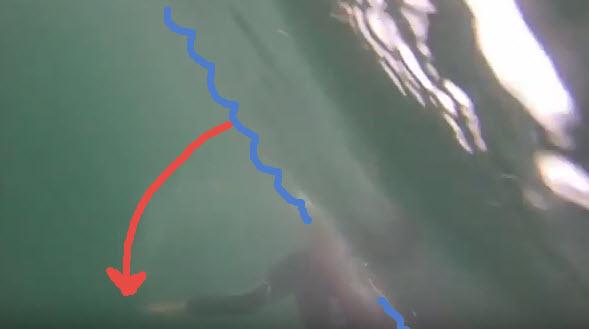The pull 'catch phase' is very important in generating power and propulsion.
Many swimmers, especially if they are self taught, will adopt a pull that follows the classic S-shape pull where you pull outwards then in then under the body; or will pull with a straight arm which in fact pushes downwards rather than behind them.
These methods are inefficient as they push the water in the wrong direction, which results in immediate loss of power and potential forward propulsion.
Take a look at the video below:
As you can see the swimmer is 'pulling' downwards, towards the seabed in other words, rather than positioning the hands at the side of the body and pushing the water back behind them to attain forward propulsion.
In addition, you can clearly see a bubble trail at the fingertips, which is a sure sign the hands have not entered the water correctly and have trapped air at the finger tips, which results in reduction of power - they're effectively pulling through air.

Tips on Arm Positioning for the Catch Phase:
Imagine yourself in a pool at the deep end. You want to get out. You can't use the steps so you have to get out using the poolside....
Is it easier to put your hands together on the poolside, arms straight out in front of you, then lift yourself out? Try it!
Or is it easier to put your hands on the poolside, positioned either side of your body with bent elbows, then pull yourself out? This generates much more power through simple leverage mechanics.
It's the same for the 'catch' phase of the front crawl pull cycle...
- The hand should enter the water cleanly on the axis line.
- The glide can be maintained for longer swims to reduce the stroke rate, increase streamlining in the water and conserve energy.
- During the glide phase the hand should remain flat, arm extended, elbow locked, but the elbow should point upwards, not out to the side. This is a weird position to start with if you are not used to it, but gets easier with practise.
- Timing is important: as soon as the breath or other arm phase has finished start the catch phase of the next arm pull. Don't try to start the pull before then as you will lose balance and throw off the body rotation.
- On the pull bend the elbow immediately and keep the wrist straight and fingers relaxed, using the whole hand and the forearm as the paddle.
- Keep the palm of the hand facing backwards at all times: this is the direction you want to be pushing the water, not down, not to the side, or under your body where you lose power through lack of leverage of the arms.
- Extend the pull all the way back, don't bring the arm out too early.
